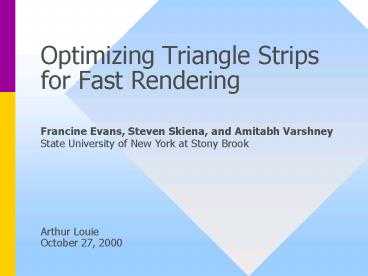Optimizing Triangle Strips for Fast Rendering - PowerPoint PPT Presentation
1 / 17
Title:
Optimizing Triangle Strips for Fast Rendering
Description:
Impact of buffer size. Summary and conclusions. Surfaces are represented as triangles. ... Increasing the buffer size helps, but the improvements diminish very ... – PowerPoint PPT presentation
Number of Views:46
Avg rating:3.0/5.0
Title: Optimizing Triangle Strips for Fast Rendering
1
Optimizing Triangle Strips for Fast Rendering
Francine Evans, Steven Skiena, and Amitabh
VarshneyState University of New York at Stony
Brook
Arthur LouieOctober 27, 2000
2
Outline
- Introduction
- Related work the SGI algorithm
- The STRIPE algorithm
- Results
- Impact of buffer size
- Summary and conclusions
3
Introduction
- Surfaces are represented as triangles.
- Rather than send all three vertices of each
triangle down the pipeline, its far better to
send triangle strips. - This is the strip (1, 2, 3, 4, 5, 6, 7, 8), where
triangle i is described by the vertices i, i 1,
and i 2.
4
Generalized triangle strips
- The previous example used a FIFO queuing
technique. - For greater freedom, introduce a SWAP command.
- Example (1, 2, 3, SWAP, 4, 5, 6)
- SWAP is supported in Iris GL, but notOpenGL.
- Simulate SWAP (1, 2, 3, 2, 4, 5, 6)
5
The problem
- How do we construct good triangle strips from
polygonal models? - First step is triangulation.
- Triangulating a polygonal model for optimal
strips is NP-complete! - Thus we must focus on heuristic techniques.
6
Goals of the algorithm
- Maximize the length of each strip
- Minimize swaps
- Minimize the number of singleton strips
7
Related work the SGI algorithm
- A greedy algorithm the next triangle in a strip
is the one with the least number of neighbors. - Starts with lowest degree and extends outward.
- In case of first tie go one level deeper.
- In case of second tie choose arbitrarily.
- This is a local approach.
8
The STRIPE algorithm
- Exploits both local and global structure.
- Global technique patchification
- Try to find large patches consisting only of
quadrilaterals. - Triangulate patches along rows or columns.Cost
either 3 swaps or 2 vertices per turn. - Enforce a patch cutoff size
- Patchification is O(pn) wherep is the number of
patchesfound.
9
The STRIPE algorithm
- Two approaches for exploiting the coherence of
large patches - Generate one strip along each row or column of
the patch - Minimizes number of swaps
- Generate one strip for the entire patch
- 3 swaps per turn
- In both cases, we removethe patches and use a
localalgorithm for the remainingtriangulation.
10
The STRIPE algorithm
- Local algorithm 2 approaches
- Dynamic whole-face triangulation
- Completely triangulate each face
- Dynamic partial-face triangulation
- Ability to triangulate and walk only part of a
face before exiting it - Fewer swaps
11
The STRIPE algorithm
- Five ways to break ties
- Arbitrary
- Use the first face found among low-adjacency
faces - Look-ahead
- Same as SGI
- Alternate
- Alternate directions (because sequential strips
alternate) - Random
- Sequential
- Choose the next face that wont produce a swap
(if none random)
12
Results
- Best approach for the OpenGL cost model
- global row/column strips
- patch cutoff size 5
- local whole-face triangulation
13
Results
14
Results
15
Impact of buffer size
- Typical buffer size is two vertices.
- Would it be worthwhile to increase?
16
(No Transcript)
17
Summary and conclusions
- Theres no practical need to develop better
algorithmsSTRIPE is very close to being optimal. - STRIPE is 10-30 better than the SGI algorithm.
- The better performance is due more to reducing
the number of swaps than the number of strips. - Increasing the buffer size helps, but the
improvements diminish very quickly. - A buffer size of about 8 is recommended.































